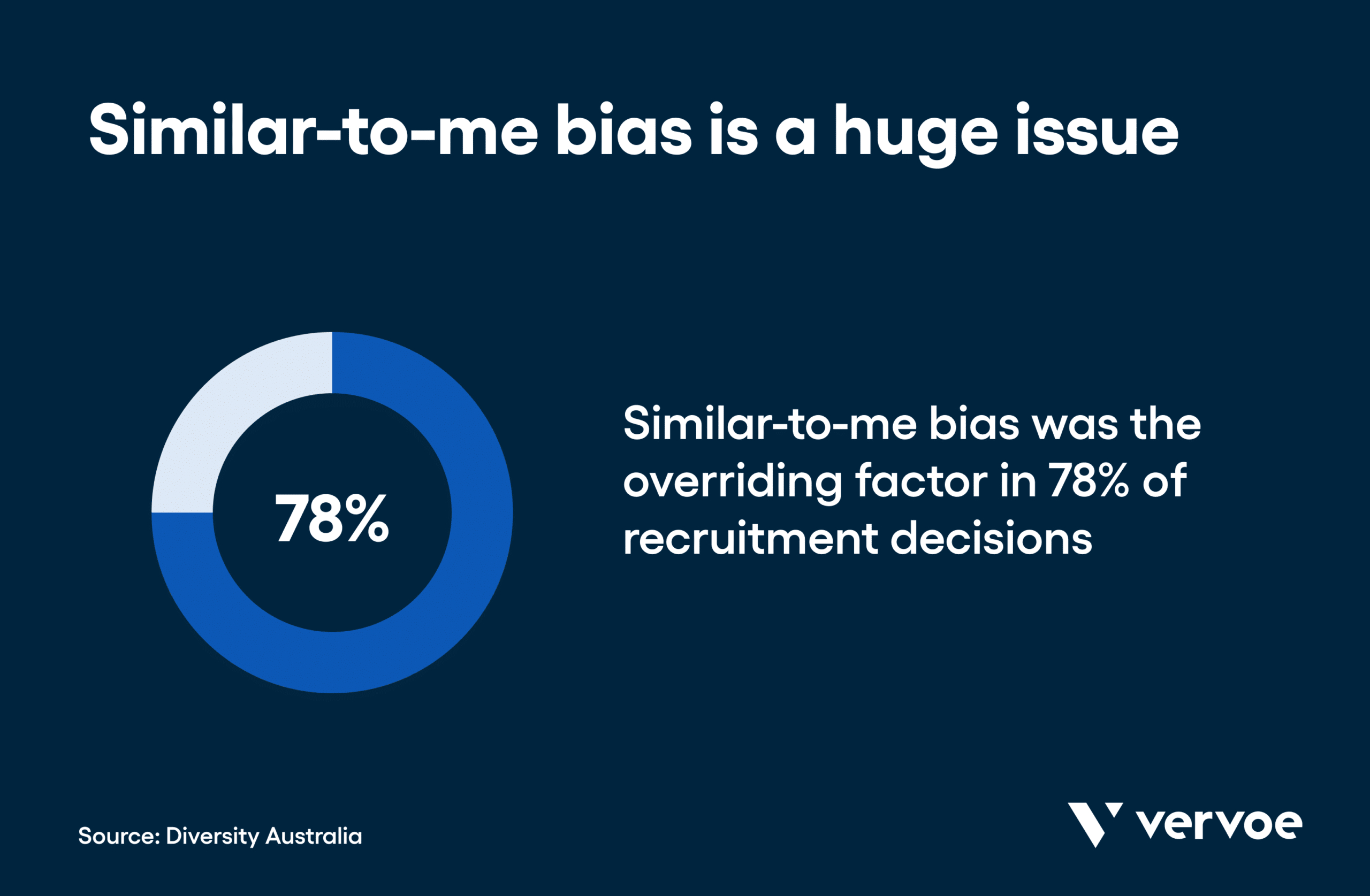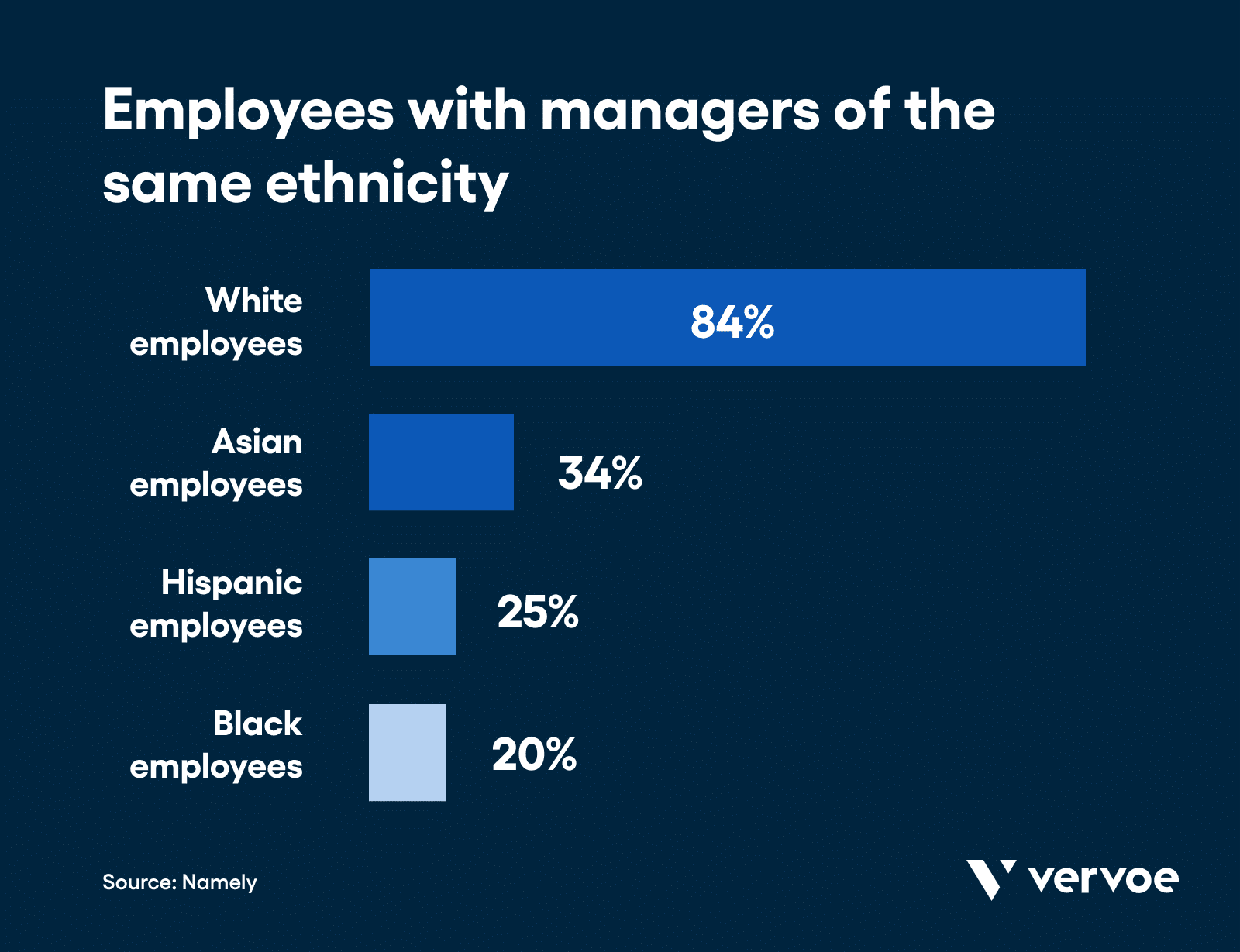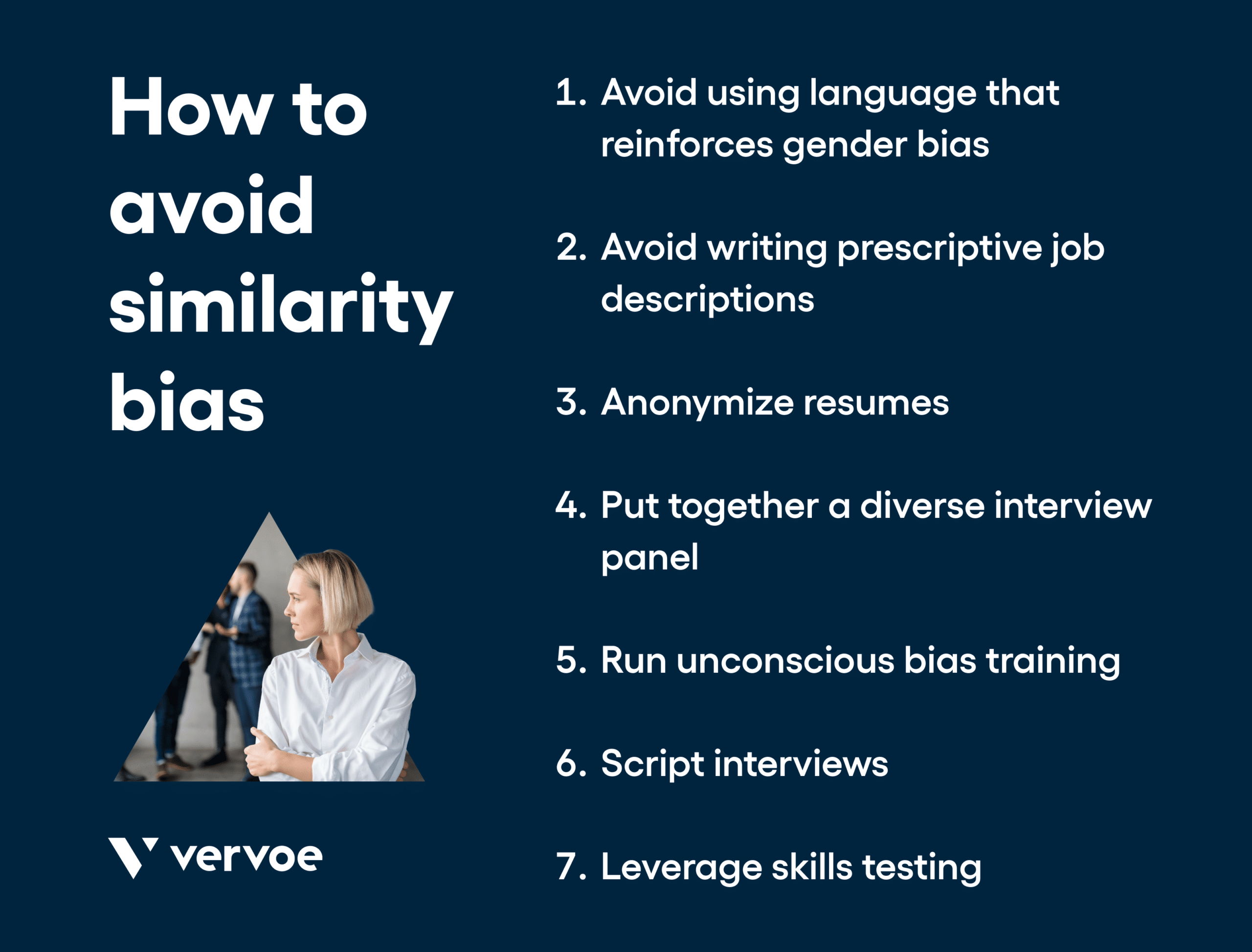Have you ever conducted a job interview and quickly realized you have very little in common with the candidate? Your taste, sense of humor, and working style don’t seem aligned and you wonder whether they’ll fit in on your team.
Then, the next candidate you interview aligns with you well. Similar style, the same sense of humor, similar taste in music and film — you can instantly imagine working and bonding with them.
You’re drawn to the candidate you had more in common with and you want to hire them. But beware, because you could be succumbing to similarity bias.
What is similarity or similar-to-me bias?
“Similarity bias” (also known as “similar-to-me” or “conformity bias”) is a term used to describe the type of unconscious bias whereby human beings are naturally drawn to, and ultimately prefer, people who are similar to them.
It’s human nature to feel an affinity with, or appreciation for, someone with whom we share common interests, experiences, and tastes. As with instances of affinity bias, the halo effect, and the horns effect, our brain uses mental shortcuts to decide whether we can find familiarity or comfort in someone when we have nothing to go on except first impressions.
Furthermore, these biases not only validate certain characteristics, such as the choices we have made in life and the opinions we hold, but they can also make it easier for us to trust someone and forge natural and meaningful relationships.
Because of these factors, we tend to surround ourselves with a whole host of like-minded people. But this becomes a problem when it seeps into our professional lives and companies start to hire candidates who all think and act the same.
History of similarity bias
Political scientist William Sumner was the first person to articulate the behaviors associated with similar-to-me bias in academic writings. He observed how people were inclined to treat others much better when they were part of their “in-group”.
He spoke at length about ethnocentrism, the concept that our own culture is superior to others, and this term has since been applied in an attempt to explain atrocities such as the Holocaust.
Years later, Henri Tajfel, a Polish social psychologist, further advanced the thinking surrounding similar-to-me bias. His theory argued that the ability for humans to form a strong sense of self is largely dependent on their group memberships. In other words, we align ourselves with and show favoritism towards similar people because it aids in the construction of a solid identity.
Where unconscious biases show up in the workplace
Unconscious biases might prove useful in certain circumstances, particularly when it comes to the forging of meaningful and long-lasting friendships. But in the workplace, similar-to-me bias has some highly negative connotations.
Similarity bias during the recruitment process
Professionals with decision-making powers are far more likely to favor someone when they share some sort of common ground. A survey conducted by Diversity Australia found that similar-to-me bias was the overriding factor in 78% of recruitment decisions by its clients. Commonalities might be linked to factors including appearance, gender, ethnicity, religion, nationality, work experience, educational background, or social class.
Imagine an interviewer considers themselves to be highly educated, well-informed, and qualified for their role. When they come across a candidate who attended the same university and studied the same course as them, they might assume that this person possesses the same credentials and mindset.
Add to the mix that the interviewer and candidate will likely get along very well, simply because they have plenty to talk about and many shared experiences, and this applicant’s chances of securing the role are looking pretty good.

Similarity bias in the workplace
Managers tend to connect with particular employees when they have lots in common.
Perhaps they share the same interests or sense of humor, or maybe they hang out in the same bars on the weekends.
As a result of this personal connection, the manager might be inclined to spend more time with this employee, offering them additional mentoring, support, and career advice. Confirmation bias means the manager will continue looking for evidence that confirms their initial impression of the employee while ignoring their shortcomings.
When it comes to holding performance reviews or shortlisting employees for promotion, the manager is far more likely to favor the employee to whom they relate to most, thinking “Why wouldn’t they make a great manager?”.
In a homogenous workplace, a certain group of employees might be especially likely to miss out on promotions or career advancement opportunities while another is lousy with them.
Consequences of similarity biases in recruitment
Falling prey to cognitive biases might mean recruiters and hiring managers spot greater potential among applicants that remind them of themselves. As a result, the office quickly becomes homogeneous.
A failure to foster a diverse workplace is disadvantageous for several reasons. A homogenous team is typically far less productive, creative and adaptable than a diverse team. It’s also much harder to solve problems, settle disputes, or find effective ways to navigate challenges when everyone has similar life experiences, opinions, and perspectives.
On the other hand, companies that successfully advance diversity and inclusion initiatives are 10 times more likely to be highly effective, and nine times more likely to innovate.
Namely’s 2018 Workplace Diversity Report found that 84% of white employees report to a white manager, which is no surprise given that white people account for the largest proportion of the workforce. But, more interestingly, 34% of Asian employees, 25% of Hispanic employees, and 20% of Black employees also have managers of the same ethnicity – percentages that significantly exceed the national workforce averages.
Furthermore, the report revealed that both men and women have a tendency to praise colleagues of their own gender more often than those of a different gender. They’re also more likely to manage people of the same gender.
Marginalized communities are far less represented in managerial positions. As such, candidates and employees from these communities will be at a significant disadvantage when it comes to career and employment opportunities. Perpetuating the process of recruiting and promoting the same type of person.

How to avoid similarity bias
Here are seven ways to ensure hiring decisions are not impacted by similar-to-me bias.
1. Avoid using language that reinforces gender bias
The first step to overcoming similarity bias during the recruitment process is to attract diverse talent.
One way to achieve this is to ensure your job descriptions are not deterring certain people from applying. There are certain words and phrases, for example, that might be associated with different genders or isolate members of the LGBTQIA+ community. It’s also important to consider ethnic, religious, racial, and age diversity when writing your copy.
2. Avoid writing prescriptive job descriptions
Being highly prescriptive about your education and qualification requirements likely favors talent from the most privileged of backgrounds. It’s important to be clear about the skill set you need, but don’t put up additional hurdles where they are simply not needed.
Consider using job advertisements to emphasize what your organization is doing to advance diversity and inclusion in the workplace as this will further reassure qualified candidates from marginalized communities and make it easier to recruit diverse teams.
3. Anonymize resumes
Some applicants will receive preferential treatment simply because of their name, age, education, background, or appearance. For example, “beauty bias” means a candidate might be favored simply because they are perceived as being handsome or well-groomed.
Anonymizing resumes before the interview process begins means candidates’ resumes will be assessed on the most important factors, such as their work experience and skill set.
4. Put together a diverse interview panel
Shortlisting a diverse range of people for a role won’t be enough to mitigate the impact of cognitive biases. A decision-maker will tend to go on to select the person whose profile most closely matches their own or based on their own opinions of what success looks like.
Assembling interview panels comprised of diverse employees can help ensure impartiality. Some hiring organizations, for example, have implemented mandates that require at least one woman to be on every interview panel.
5. Run unconscious bias training
Unconscious bias training raises awareness about the different types of cognitive bias and how they can impact an organization. Attendees will learn about how to mitigate the risk of cognitive biases, where and when instances are most likely to occur, and who is most vulnerable to its effects.
6. Script interviews
Similar-to-me bias can make it difficult for decision-makers in your organization to interact with someone as a prospective employee, rather than as a friend. Once you discover that you have a lot in common with a candidate, it will likely dictate the tone of the conversation and the questions you ask them.
Scripting interview questions and introducing a marking system will ensure applicants have an equal opportunity to succeed and increase the likelihood of organizations building diverse and inclusive teams.
7. Leverage skills testing
One of the best ways to prevent hiring managers and recruiters from leaning into unconscious biases during the hiring process is to leverage skills testing and situational assessments.
Vervoe’s skills assessments, for example, enable hiring organizations to assess hundreds of applicants simultaneously and under the same conditions. This means every applicant has an equal chance to show their talent, regardless of what their resume says or how well they might get along with the hiring manager.
Our platform is 83% accurate in predicting top performers across all job types, no matter what your industry.
Summary
In recruitment, similarity bias will draw recruiters and hiring managers towards candidates that remind them of themselves. These candidates may receive special treatment, such as easier interview questions, while their shortcomings may be overlooked.
When decision-makers repeatedly hire people similar to themselves, the workplace becomes homogeneous and innovation, diversity and inclusion, and productivity are impacted.
To curb the impacts of similarity bias hiring organizations should consider tactics such as anonymizing resumes, providing unconscious bias training, standardizing interview questions, and implementing skills assessments.
Then they improve their chances of hiring better employees through a fairer process, focusing on what candidates can do, rather than how much they have in common with their manager.






















